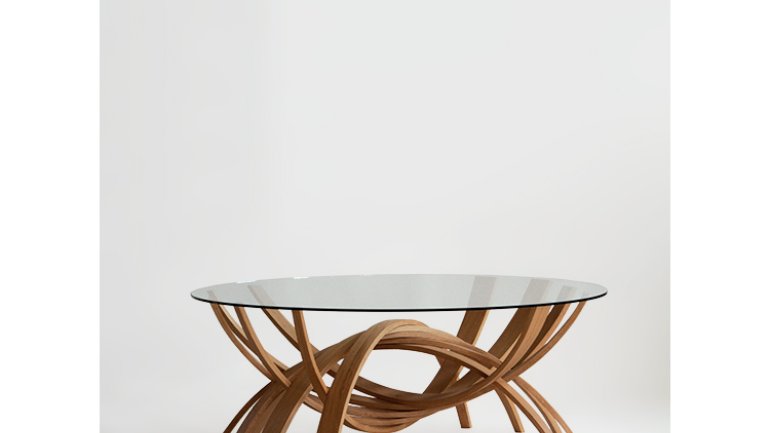A Space in Between
A Space in Between
Sometimes, when Michaela Crie Stone is feeling overwhelmed, she’ll take to her studio, grab an awl, and start piercing pieces of ash, oak, cherry, and maple. Just two years into her woodworking career, Stone, 24, is already known around Rockport, Maine, for the simple wooden boxes she pierces with earthy patterns of leaves, webs, branches, and bulbs.
“I sell them almost as fast as I make them,” she says. “But these are just simple designs, basically just sketches for me when I’m decompressing from my more mathematically complex work.”
Turns out, it takes a rested body and mind to devise deceptively simple pieces such as the Parabola coffee table, Sinuate chair, and Chiasm bench. These objects are made entirely from modules, with dozens of standardized pieces forming the larger, functional whole. Though these works are painstakingly engineered, they also lean toward the conceptual. Stone’s Parabola table, for instance, is fanned with 100 maple strips, the idea being “to create a curve using only straight lines,” she says.
A self-described “science nerd,” Stone arrived at Skidmore College in 2007, planning to major in biology. “But I’ve always had this dichotomy between art and science,” she says. Sure enough, her painting and sculpture electives proved more seductive than she had expected – “Let’s just say, the hours spent in the studio far outnumbered hours spent in the lab.” So Stone majored in studio art with an emphasis in sculpture, and spent her time building work with graceful, nature-inspired themes (she harbored a particular fascination for marine life such as coral and anemones) and complicated, geometric structures. An observer easily spots the family resemblance between these early sculptures and Stone’s newer functional work.
Stone graduated in 2011 and, like many broke college kids these days, quickly landed back home with her parents. She applied for a two-week basic woodworking class at the Center for Furniture Craftsmanship in Rockport “because it’s around the corner from my parents’ house,” she says.
Stone thrived within the relative confines of furniture making. “I was getting really overwhelmed in the sculpture studio because there are no rules,” she confesses. “Having parameters was really necessary for me.” Soon she enrolled in a 12-week intensive furniture-making course, and now she works part time for the center, doing development and media work.
Stone was quick to impress her teachers. Tim Rousseau, a resident furniture maker and instructor at the center, immediately noticed Stone’s eye for proportion and her ability to work through ideas. Stone can create “geometric forms with simple shifts in frames,” says Rousseau. He particularly admires the Sinuate chair, a study in roundness with its moony contours of ash, steel, and leather. Meanwhile, the purportedly simple designs of those piercings are “testaments to her amazing hand skills.”
Beth Ireland, another of Stone’s teachers and mentors, observes that many artists (she includes herself) feel an internal tug-of-war between sculpture and functional craft. They suspect it’s an either/or proposition, or they might lack confidence that they can reconcile the two. “But Michaela feels perfectly comfortable in this in-between state,” says Ireland. “Her portfolio is that of a much older artist, and yet she explores subject matter like a kid – fearlessly.”
Stone might be focusing on furniture for now, but she hasn’t abandoned the idea of sculpture entirely. She’s heading for a spring residency at Anderson Ranch Arts Center in Colorado, where she plans to play with her sculptural vocabulary, setting aside concerns with functionality. “Hopefully I’ll find a space where I can bring metalworking back to my practice,” she says, referring to her earlier work in jewelry and sculpture.
For now, Stone believes some of her modular furniture already bridges the considerable divide between sculpture and practical purpose. “I have this really strong conviction about my Parabola coffee table,” she says. “Even though it’s a perfectly functional coffee table, there’s something about the volume in the center that, to me, has a more sculptural aspect.”
Bearing out Ireland’s observation about her conceptual strengths, Stone riffed on this theme a while longer: “I’m not convinced fine art and functional craft need to be separate. I think there’s a space in between those two worlds, and maybe that’s a place for people like me.”
Michaela Crie Stone’s work will be in the Society of Arts and Crafts’ 2014 Artists Awards exhibition, running May 2 through July 19 in Boston. Christy DeSmith is a Minneapolis-based freelance writer who covers arts, culture, and travel.

